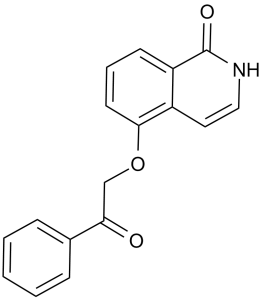UPF 1069 (UPF-1069), an isoquinolinone derivative, is a novel, potent and selective inhibitor of poly-(ADP-ribose) polymerase 2 (PARP-2) with potential neurprotective and anti-ischemic effects in vivo. It inhibits PARP-2, with IC50 values for PARP-1 and PARP-2 of 8 and 0.3 μM, respectively. It can decrease PAR formation and cause apoptosis in nuclear extracts from PARP-1-/-fibroblasts as well as in recombinant enzyme preparations. With an IC50 of 8 μmol/L, UPF 1069 exhibits greater selectivity for PARP-2 compared to PARP-1. It has been applied to study the function of PARP-1 and PARP-2 in brain damage following an ischemia.
Physicochemical Properties
| Molecular Formula | C17H13NO3 | |
| Molecular Weight | 279.29 | |
| Exact Mass | 279.089 | |
| Elemental Analysis | C, 73.11; H, 4.69; N, 5.02; O, 17.19 | |
| CAS # | 1048371-03-4 | |
| Related CAS # |
|
|
| PubChem CID | 25015515 | |
| Appearance | White to off-white solid powder | |
| Density | 1.3±0.1 g/cm3 | |
| Boiling Point | 570.3±50.0 °C at 760 mmHg | |
| Melting Point | 166-168 °C | |
| Flash Point | 298.7±30.1 °C | |
| Vapour Pressure | 0.0±1.6 mmHg at 25°C | |
| Index of Refraction | 1.618 | |
| LogP | 2.22 | |
| Hydrogen Bond Donor Count | 1 | |
| Hydrogen Bond Acceptor Count | 3 | |
| Rotatable Bond Count | 4 | |
| Heavy Atom Count | 21 | |
| Complexity | 426 | |
| Defined Atom Stereocenter Count | 0 | |
| InChi Key | JJWMRRNGWSITSQ-UHFFFAOYSA-N | |
| InChi Code | InChI=1S/C17H13NO3/c19-15(12-5-2-1-3-6-12)11-21-16-8-4-7-14-13(16)9-10-18-17(14)20/h1-10H,11H2,(H,18,20) | |
| Chemical Name | 5-phenacyloxy-2H-isoquinolin-1-one | |
| Synonyms | UPF 1069; UPF1069; UPF-1069 | |
| HS Tariff Code | 2934.99.9001 | |
| Storage |
Powder-20°C 3 years 4°C 2 years In solvent -80°C 6 months -20°C 1 month |
|
| Shipping Condition | Room temperature (This product is stable at ambient temperature for a few days during ordinary shipping and time spent in Customs) |
Biological Activity
| Targets | PARP-2 ( IC50 = 0.3 μM ); PARP-1 ( IC50 = 8 μM ) | ||
| ln Vitro |
|
||
| ln Vivo |
|
||
| Enzyme Assay | Recombinant mouse PARP-2 and bovine PARP-1, which are readily available for purchase, are used to measure PARP activity. The enzymatic reaction is conducted in 100 µL of 50 mM Tris-HCl (pH 8.0) supplemented with 5 mM MgCl22, 2 mM dithiothreitol, 10 µg of sonicated calf thymus DNA, 0.2 µCi [adenine-2,8-3H]NAD, and recombinant enzyme PARP-1 or PARP-2 (0.03 U per sample). That is, in brief. The mixture is mixed and incubated at 37°C for one hour at varying concentrations of the potential inhibitors. After adding 1 mL of 10% trichloroacetic acid (w/v) to stop the reaction, the mixture is centrifuged. Following two washings in 1 mL of H2O, the pellets are resuspended in 1 mL of 0.1 M NaOH. Liquid scintillation spectrometry is used to measure the radioactivity incorporated from [adenine-2,8-3H]NAD into proteins[2]. | ||
| Animal Protocol |
|
||
| References |
[1]. On the way to selective PARP-2 inhibitors. Design, synthesis, and preliminary evaluation of a series of isoquinolinone derivatives. ChemMedChem. 2008 Jun;3(6):914-23. [2]. Selective PARP-2 inhibitors increase apoptosis in hippocampal slices but protect cortical cells in models of post-ischaemic brain damage. |
Solubility Data
| Solubility (In Vitro) |
|
|||
| Solubility (In Vivo) |
Solubility in Formulation 1: ≥ 2.5 mg/mL (8.95 mM) (saturation unknown) in 10% DMSO + 40% PEG300 + 5% Tween80 + 45% Saline (add these co-solvents sequentially from left to right, and one by one), clear solution. For example, if 1 mL of working solution is to be prepared, you can add 100 μL of 25.0 mg/mL clear DMSO stock solution to 400 μL PEG300 and mix evenly; then add 50 μL Tween-80 to the above solution and mix evenly; then add 450 μL normal saline to adjust the volume to 1 mL. Preparation of saline: Dissolve 0.9 g of sodium chloride in 100 mL ddH₂ O to obtain a clear solution. Solubility in Formulation 2: ≥ 2.5 mg/mL (8.95 mM) (saturation unknown) in 10% DMSO + 90% Corn Oil (add these co-solvents sequentially from left to right, and one by one), clear solution. For example, if 1 mL of working solution is to be prepared, you can add 100 μL of 25.0 mg/mL clear DMSO stock solution to 900 μL of corn oil and mix evenly. Solubility in Formulation 3: 2% DMSO+30% PEG 300+5% Tween 80+ddH2O: 5mg/mL (Please use freshly prepared in vivo formulations for optimal results.) |
| Preparing Stock Solutions | 1 mg | 5 mg | 10 mg | |
| 1 mM | 3.5805 mL | 17.9025 mL | 35.8051 mL | |
| 5 mM | 0.7161 mL | 3.5805 mL | 7.1610 mL | |
| 10 mM | 0.3581 mL | 1.7903 mL | 3.5805 mL |
